Lived Experiences, by Race, Influenced Reactions
The New York Daily News Sent Me; I Was Blown Away
Support Journal-isms
Donations are tax-deductible.
O.J. Simpson’s first interview since the “trial of the century” aired live on Black Entertainment Television (BET) on Jan. 25, 1996. BET’s Ed Gordon conducts the interview. (Credit: YouTube)
Lived Experiences, by Race, Influenced Reactions
The case of O.J. Simpson, who died of cancer Wednesday at 76, became “one of the first times that I remember in the newsroom that we as journalists saw things differently because of our lived experience,” Wanda Lloyd (pictured), then an editor at USA Today, recalled for Journal-isms.
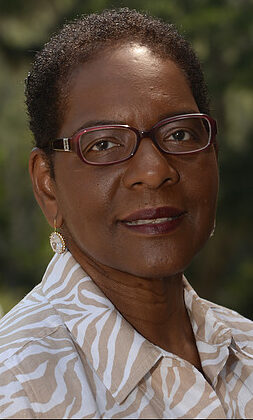 “To his credit, Peter Prichard, editor of USA Today, picked up on the divide right away,” Lloyd wrote in her 2020 memoir, “Coming Full Circle: From Jim Crow to Journalism.” “He wanted to understand what was happening around us. In those sessions we talked about our different emotions, and why one group did not have a clue that the other group would react the way we did.”
“To his credit, Peter Prichard, editor of USA Today, picked up on the divide right away,” Lloyd wrote in her 2020 memoir, “Coming Full Circle: From Jim Crow to Journalism.” “He wanted to understand what was happening around us. In those sessions we talked about our different emotions, and why one group did not have a clue that the other group would react the way we did.”
It was 1995. Simpson was the defendant in a murder trial, and his “rise and fall from American football hero to accused murderer to prison inmate fueled a rancorous public drama that obsessed the nation and spawned debates over race, wealth, justice and retribution,” as Elaine Woo reported Thursday in the Los Angeles Times.
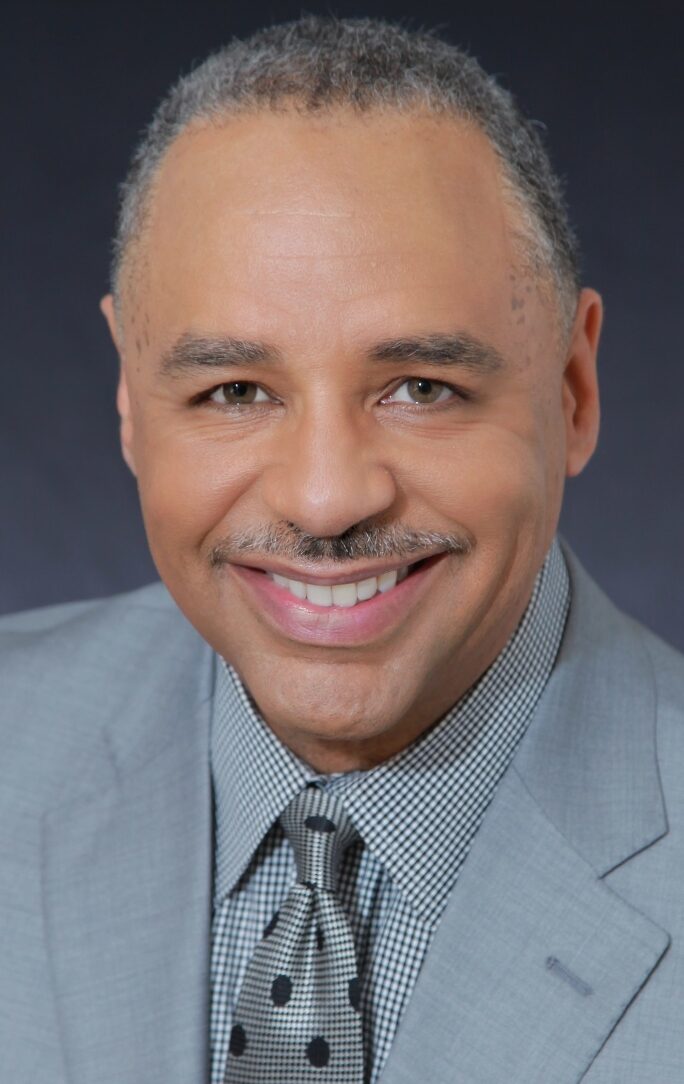 Ed Gordon (pictured), whose career went into what he calls “rarified air” after he nabbed an interview with Simpson for BET and won praise for his professionalism, recalls how some white people didn’t think much of Simpson’s choice of Gordon as interviewer — made after Simpson’s first choice, NBC, was believed to want to emphasize “gotcha” questions.
Ed Gordon (pictured), whose career went into what he calls “rarified air” after he nabbed an interview with Simpson for BET and won praise for his professionalism, recalls how some white people didn’t think much of Simpson’s choice of Gordon as interviewer — made after Simpson’s first choice, NBC, was believed to want to emphasize “gotcha” questions.
[BET scored its highest-ever prime time rating to date but was criticized for letting Simpson promote his $30 mail-order video during the broadcast. Journalist Brett Pulley’s book on BET founder Bob Johnson, “The Billion-Dollar BET,” says Simpson agreed to do the interview only because of that deal, and that a displeased Gordon persuaded BET not to air the video commercials during the show, only before and after.]
That Jan. 24,1996, interview “catapulted me from being known to Black folks to being known all over,” Gordon told Journal-isms. He moved to NBC News, he even became a sex symbol. Still, even today, he says, the feeling that Black journalists can’t be fair remains.
As Woo reported, “Simpson was once the country’s most admired athlete, a formidable running back who broke records with grace and determination. He became a crossover star, lending his handsome face and affable personality to the slapstick ‘Naked Gun’ movies and classic television commercials for Hertz.
“He served time at Lovelock Correction Center, 90 miles northeast of Reno, where he served nine years of a 33-year sentence after his 2008 conviction on armed robbery, kidnapping, conspiracy and other charges stemming from his attempt to recover valuable memorabilia he claimed was stolen from him. His incarceration was widely viewed as long-overdue punishment for the 1994 slayings of his ex-wife, Nicole Brown Simpson, and her friend, Ronald L. Goldman.
“Although widely presumed to be guilty of the killings, the former USC Heisman Trophy winner was acquitted in 1995 in a spectacular trial that was rife with vexing questions, none more divisive than the one posed by Simpson’s defense team: whether a Black man in America — even one who had crossed racial barriers and attained significant wealth and status — could be tried without prejudice for the slayings of a white person. Polls showed deep fissures between Black people and white people on the question of his innocence. When a predominantly Black jury set him free, it drew those racial suspicions into even sharper relief. . . .”
 Greg Moore (pictured), managing editor of the Boston Globe from 1994 to 2002, recalled, “There are two things I remember about that whole time. Watching the Bronco chase on TV as it unfolded, it was just quiet. And a white editor came up to me and asked me why would OJ Simpson do something like this if he’s innocent. And I said because he knows his life as he knew it was over — whether he was innocent or not.
Greg Moore (pictured), managing editor of the Boston Globe from 1994 to 2002, recalled, “There are two things I remember about that whole time. Watching the Bronco chase on TV as it unfolded, it was just quiet. And a white editor came up to me and asked me why would OJ Simpson do something like this if he’s innocent. And I said because he knows his life as he knew it was over — whether he was innocent or not.
“And my white colleague looked deeply into my eyes and said as long as you’re alive there’s always hope.
“I remember thinking what a luxury white people have when it comes to hope. And later I explained that to him and many others over the months ahead. Once the narrative is set, it’s almost impossible to change it. And even though OJ had prospered in the white world, he knew it was over for him. There is a gulf of reality between Black and white people based on lived experience.
“Being in a position to facilitate those sometimes raw discussions was a unique space in some ways only a Black editor could fill. The second thing that stands out is the announcement of the verdict. Walking around people’s desks and speaking to those gathered around the televisions urged them to be calm and professional. No cheering or screaming. I know many of us have strong feelings about this but this is a newsroom and we need to be covering this story.
“Over the days and weeks we had plenty of frank discussions about the racial divide over the reactions to the verdict. And I think some new insights were gained. But journalists of color were on the leading edge in bringing those insights to light. It was an interesting time.”
It was much the same for Caesar Andrews, who at the time was executive editor at the Rockland (N.Y.) Journal-News. “Right after the verdict, while the newsroom was kicking into high gear for special coverage, a gentle, conscientious White colleague sought me out for a quiet chat,” Andrews messaged.
“TV news kept repeating crowd videos of White people deflated at the point of announcement. While many Black people cheered. My colleague asked me the equivalent of: What just happened? I had no clue that the jury would go with not guilty. But I was able to answer the question right away. Black people may or may not side with O.J. Simpson. But many had experiences that encouraged little to no faith in the justice system. Emotions on display after verdict were a proxy for something much bigger than Simpson.”
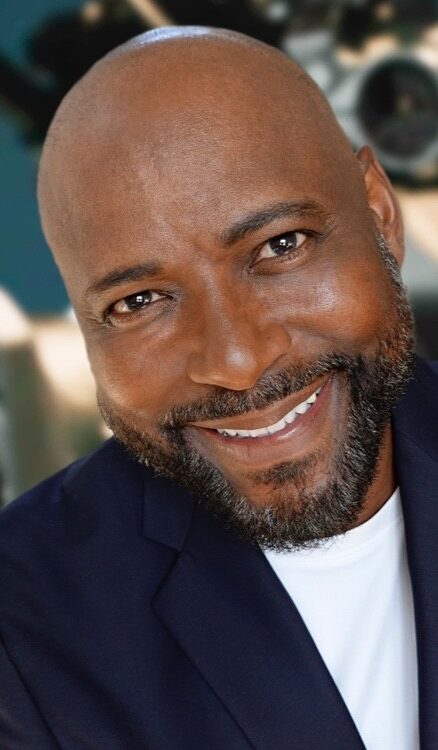 Recalls Art Fennell (pictured), a broadcast journalist who was president of the National Association of Black Journalists from 1995 to 1997, “Not only was it the Trial of the Century, but it was also one of the biggest stories of the Century,” he messaged Journal-isms. “Long before social media, the OJ trial captivated headlines, social commentary and race relations for years.
Recalls Art Fennell (pictured), a broadcast journalist who was president of the National Association of Black Journalists from 1995 to 1997, “Not only was it the Trial of the Century, but it was also one of the biggest stories of the Century,” he messaged Journal-isms. “Long before social media, the OJ trial captivated headlines, social commentary and race relations for years.
“And it’s still a riveting topic even today. What the hell really happened that night in Brentwood? Did OJ do it or not? For Black Journalists, many of us were torn. There were newsroom debates over what responsibility we had to try and ward off stereotypes and balance the obvious racial divide, when in your gut you may have been thinking…’Yeah OJ did it’.
“For me personally, I even traveled to the crime scene on Gretna Green to try and retrace the steps and timeline of what may or may not have happened that fateful night. But there were no easy answers to be found, not then, not now.”
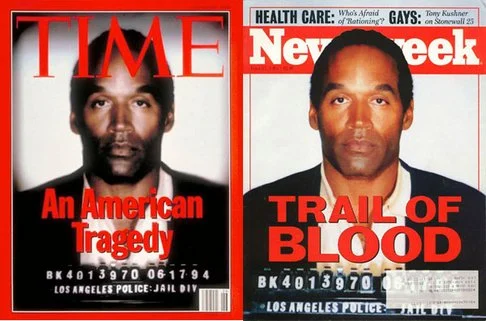
The “trial of the century” could hardly escape comment from NABJ, especially after the June 27, 1994, cover of Time magazine featured a cover photo of Simpson that appeared to darken his skin.
Then-NABJ President Dorothy Gilliam said at the time, The “question that must be asked is how does darkening and shadowing this photograph serve the reader?” Wayne Dawkins reported in his 2003 book, “Rugged Waters: Black Journalists Swim the Mainstream.”
Gilliam continued, “Tampering with a photograph in a criminal case is even more serious. The cover appears to be a conscious effort to sway the opinion of the reader to becoming fixated on his guilt.”
Time’s art director, Arthur Hochstein, said, “There was no conscious intention to make O.J.’s skin appear darker than it is or make him look any guiltier than he may be.”
O.J. and his trial did not exist in a vacuum. Simpson may or might not have said “I’m not Black, I’m O.J.,” as has been reported, but his trial and acquittal made him a racial stand-in for many Black people.
“It’s not that most Black people thought him innocent or another Rosa Parks,” Charles M. Blow wrote Thursday in the New York Times. “For them, it was the system itself that was on trial. The question wasn’t whether the justice system would work equally in the service of justice but whether its inherent and inveterate injustices would also be applied equally.
“The Simpson trial came in the shadow of the trial of the police officers who savagely beat Rodney King and were still found not guilty. Los Angeles exploded in riots. Scores of people were killed. Buildings were reduced to ashes. It was one of the costliest riots, in terms of property damage, in American history.”
And so Andrea Ford, a Black journalist who covered the trial for the Los Angeles Times, offered her NABJ colleagues seven rules for covering the next “Trial of the Century,” Dawkins reported.
Among them:
“1. Hang on. You are likely the last kid on the rope in the ‘crack the whip’ game. Don’t ask why, but there’s an unwritten law in ‘mainstream’ [news] organizations that the really, really big stories or really big developments are best understood by whites. A black reporter on such an assignment should be ever watching his or her back — and front, too for that matter. And don’t go on vacation: that’s like bodily flinging yourself off the end of the whip.
“2. Never say anything publicly or even privately that can be construed as favorable to whoever the most news organizations have deemed to be the villain in the story, especially if the ‘villain’ is black.
“3. Don’t break too many stories that your editors believe came from black ‘villains’. You know you have broken this rule when people start asking you things like, ‘Just how long have you known Johnnie Cochran?’
“5. Remember, you don’t speak for black people, but also remember that you might have to speak up for them.”
- Emmanuel Felton and Rachel Hatzipanagos, Washington Post: What O.J. Simpson meant to Black America
- Michael Harriot, the Grio: The whitewashing of O.J. Simpson (April 12)
- Derrick Z. Jackson, Boston Globe: Before We Can Really Fight Crime, We Have to Get Over Race-Based Hysteria (Aug. 23, 1994; updated Sept. 25, 2021)
- Derrick Z. Jackson, Boston Globe: The Evidence Is in: Crime News Is Colorized (Aug. 23, 1994; updated Oct. 24, 2018)
- Mike Jackson, Tampa Bay Times: Media handling of Simpson case gets harsh review (July 31, 1994; updated Oct. 7, 2005)
- R.H. Melton, Washington Post: Reflections in a Polarized Mirror: In the Washington Area, Like the Country, Race Leads the Reaction (Oct. 3, 1995)
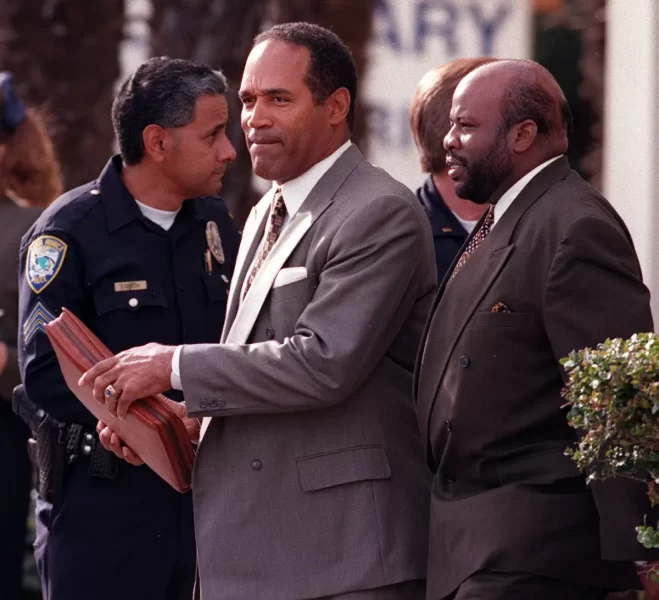
O.J. Simpson leaves a Santa Monica courthouse after his civil trial ended and the jury began deliberations on Jan. 18, 1997. (Credit: Gina Ferazzi/Los Angeles Times)
The New York Daily News Sent Me; I Was Blown Away
By Austin Fenner (pictured)
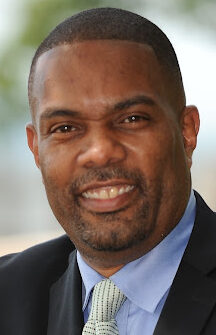 When I was a reporter at the New York Daily News, Editor-in-Chief Pete Hamill recognized how much race was driving the current of the O.J. Simpson saga.
When I was a reporter at the New York Daily News, Editor-in-Chief Pete Hamill recognized how much race was driving the current of the O.J. Simpson saga.
The civil trial was important for the Daily News, a tabloid. Hamill looked out at the ocean of reporters in the main newsroom, looking for an additional man on the ground to cover the trial’s culmination, a month-long assignment. Hamill saw that he had no African American reporters to easily choose from.
The Daily News had two main reporters covering the entire story, from the heinous twin murders of Nicole Simpson and Ron Goldman to the double courtroom sagas.
Jere Hester was in the New York newsroom and ace reporter Michelle Caruso was in the courtroom. The News had been flying in reporters during the two-plus years of the Simpson saga.
The editors on the desk must have mentioned that we have this kid in the Brooklyn bureau.
Hamill brought me into the editor’s office, which is the equivalent of sitting in a church confessional; that kind of meeting meant this talk is a big deal.
Hamill shared a story of how he was in the South during the civil rights movement and shared a reporting technique. He witnessed a historic march, but one block away, he saw a guy cleaning his car. Hamill interviewed him and used the conversation to get into the nuts and bolts of the major story.
My head was swirling.
I was simply blown away that Hamill picked me for this big assignment.
I knew I had to do more than my best because every news agency was sending its most dogged reporters to cover the trial of the century.
I was lucky enough to get about three stories on the national news wire.
One was about whether Black people would riot if Simpson were found guilty. Another, the crowd on the doorsteps of the Santa Monica courthouse. The final story was about the guilty verdict after the civil trial.
Every day after the court broke for the day, broadcast reporters, print and radio would flock to the Doubletree Hotel and try to get chummy with Ron Goldman’s family lawyer, who was prosecuting the civil case.
I was reporting to national editor Diane Goldie, whose demeanor was a calming force amid the constant deadline pressure. I must give the ultimate compliment to one of the greatest editors to grace a newsroom. The late Hap Hairston gave me confidence to be bullish reporter.
A feverish crowd of hundreds hovered outside the courthouse, and most only wanted to hear the words “guilty.”
After the jury delivered the guilty verdict, the crowd ripped with jubilation.
One man who stood out from the bunch, almost in a leadership capacity, yelled “let’s lynch him.”
Clearly, it’s disturbing to be in a crowd of mostly Caucasian folks and hear such a call. It makes you examine your surroundings.
When I called the rewrite desk and reported the chant, the reporter responded, “oh, we can’t print that.”
It never made it into the paper.
Austin Fenner is a New York journalist and consultant
‘Worst 33 Days of My Life’
April 8, 2024
Gaza Journalist Describes His Detention by Israel
Terry Tang Named L.A. Times’ First Female Top Editor
Coalescing: Environmental Journalists of Color
Amnesty International Calls Out Cuba on Denial of Freedoms
James Washington Dies, Trailblazer for Black Press
Marvin Lake, Virginian-Pilot Pioneer, Had Dementia
Short Takes: Don Lemon-Tim Malone wedding; solar eclipse and Benjamin Banneker; HBCU audio archives; D.C. Journalism Job Fair; hair relaxer products; teaching Asian American and Hmong American histories; Miguel Gonzalez; Diana Maltez; media blocked from witnessing executions; Tony Regusters, Nancy Ancrum services; Sudan suspends broadcasters.
Support Journal-isms
Donations are tax-deductible.
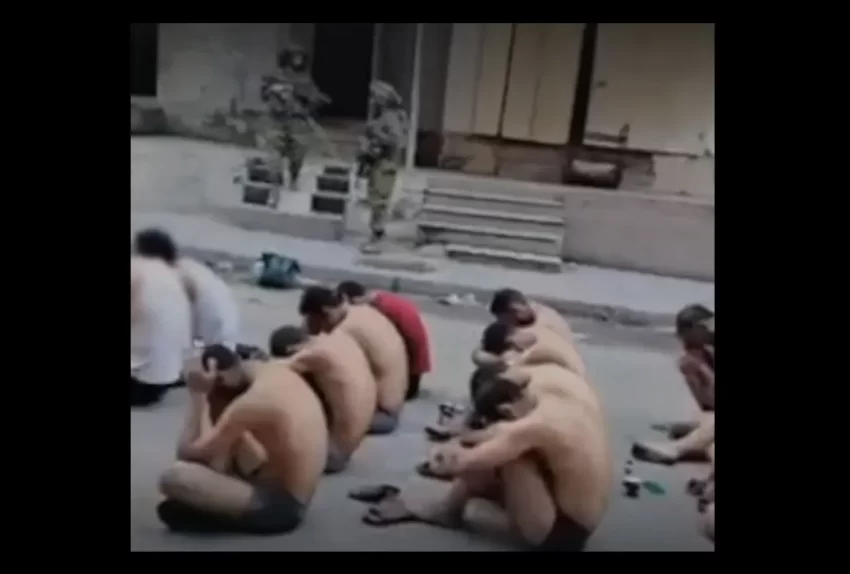
A video image shown by the BBC on Dec. 8 depicts the mass arrest of Palestinians from Beit Lahya in Gaza. The Israel Defense Forces told the BBC that “IDF fighters and Shin Bet officers detained and interrogated hundreds of terror suspects” on Dec. 7. (Screenshot: Video obtained by BBC)
Gaza Journalist Describes His Detention by Israel
“On December 7, Diaa Al-Kahlout, a 38-year-old Palestinian journalist, was detained by Israeli troops in Beit Lahia, northern Gaza,” Luis De Vega reported Feb. 7 for Spain’s El Pais. “He and several dozen men were forced to strip to their underwear and stand in the middle of the street. Videos and photos recorded by Israeli Defense Forces (IDF) leaked out and spread throughout the world, sparking widespread condemnation. Al-Kahlout can be seen sitting on the ground with over 100 other detainees.
“He endured over a month of captivity in Israeli territory, facing torture, interrogation and humiliation. On January 9, he was released without charges and returned to Gaza. ‘The worst 33 days of my life,’ Al-Kahlout told us in a phone call from the tent he shares with other displaced people in Rafah, near the Egyptian border. . . .”
The Committee to Protect Journalists published a more extensive interview with Al-Kahlout on Thursday, providing this context:
“Six months into the Israel-Gaza war, Gaza’s journalists remain almost the sole eyes and ears on the ground as foreign correspondents are effectively barred from the territory,” CPJ said. “The Gaza press corps has paid a heavy price for its coverage, with scores killed, injured, or arrested.
“ ‘The truth is, that the outside world sees only 10% of the actual reality in Gaza, and what we see is unimaginable,’ local journalist Diaa Al-Kahlout told CPJ’s Doja Daoud. Al-Kahlout spent 33 days in Israeli detention, where he says he was brutally interrogated about his work. ‘In addition to the bruises still on my body, I can’t sleep or rest normally since my release,’ he said. ‘I used to be able to get all the news, and today, many significant stories haven’t been covered.’ “
More specifically, Al-Kahout told CPJ, “Detention left its mark on me, both psychologically and health-wise. The most significant issue I face is with my vision, as I cannot see well due to being blindfolded for 33 consecutive days and nights. My vision was excellent before my arrest.
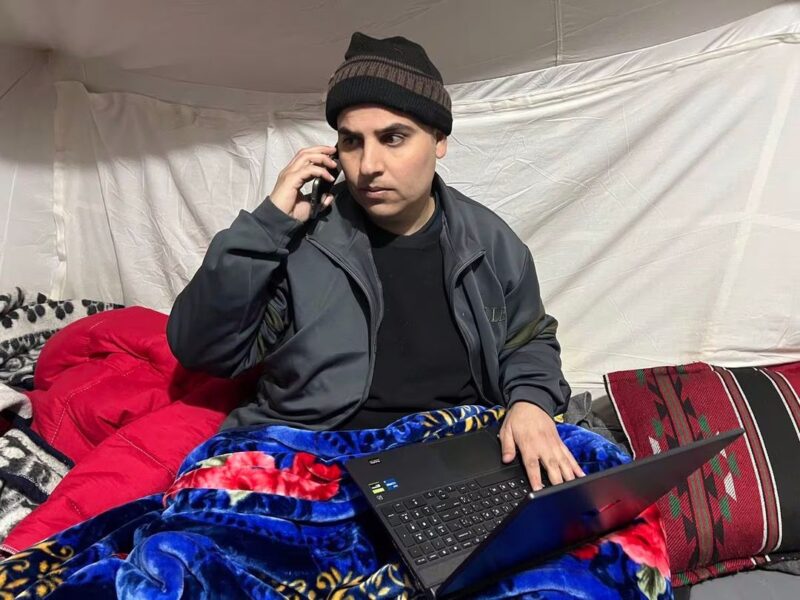
Journalist Diaa Al-Kahlout in the tent that is his home and office in Rafah, southern Gaza.(Credit: Mohamed Al Kahlout)
“In detention, we were beaten and ‘ghosted’ if any part of our eyes showed. I have severe chest inflammation and acute vertebral inflammation, resulting in leg pain, in addition to malnutrition, and lack of sleep. Before my travel, the cracks in my skin caused by detention conditions resulted in pus and severe pain. . . . I behave as if I were still in prison; even my sleep was affected by the prison experience and what I suffered. I would sleep in the same position we were forced into during detention. . . .”
The press-freedom group continued, “Other journalists are struggling to continue reporting in the face of food, fuel and equipment shortages, supply restrictions, and power outages.
“Three organizations providing material aid to journalists on the ground — Arab Reporters for Investigative Journalism, the Palestinian Journalists’ Syndicate, and [Palestinian NGO] Filastiniyat — spoke with CPJ’s Lucy Westcott about what journalists need to continue reporting and surviving. ‘They really expect to die daily,’ said PJS communications officer Rania Khayyat. . . . “
- Jon Allsop, Columbia Journalism Review: The frightening backdrop to an Iranian journalist’s stabbing in London
- Perry Bacon Jr., Washington Post: These progressives were right about Gaza. Now it could cost them their seats. (March 26)
- LZ Granderson, Los Angeles Times: Netanyahu owes the U.S. better answers about Gaza
- Sharon Waxman, The Wrap: The ‘Tectonic Shift’ in Media That Changed Perceptions of Israel: ‘What’s Left Is a System Run by Activists’ (April 1)
- Dan Williams and Andrew Mills, Reuters: Netanyahu pushes to shut Israeli office of Qatar’s Al Jazeera TV
Tang Named L.A. Times’ First Female Top Editor
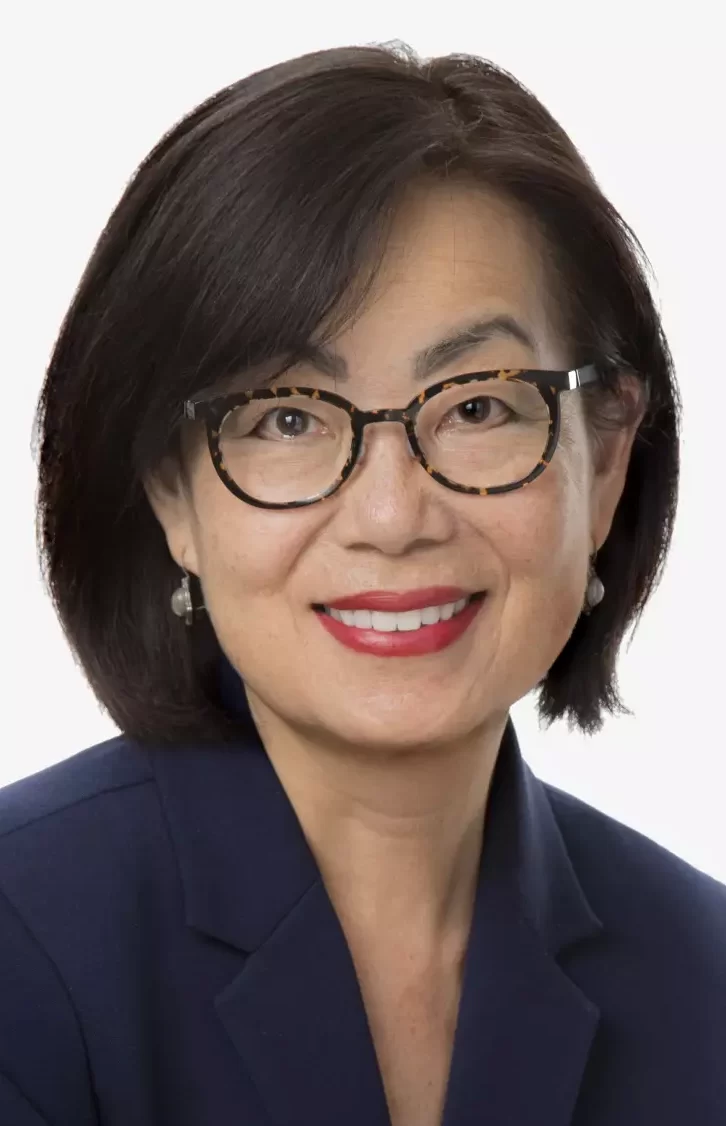 “The Los Angeles Times is removing ‘interim’ from executive editor Terry Tang’s (pictured) job title,” Katie Kilkenny reported Monday for the Hollywood Reporter.
“The Los Angeles Times is removing ‘interim’ from executive editor Terry Tang’s (pictured) job title,” Katie Kilkenny reported Monday for the Hollywood Reporter.
Tang becomes the Times’ first female top editor and the rare Asian American woman in such a role at a metro daily. In 2022, Jennifer Kho, whose background is Indonesian, became the first woman and the first person of color to lead the Chicago Sun-Times newsroom.
Kilkenny continued, “The newspaper announced on Monday that it was making things official with its former editorial page editor, who was elevated to the leadership role on a provisional basis in January. ‘We’re thrilled to have Terry Tang leading the L.A. Times newsroom,’ owners Patrick and Michele Soon-Shiong said in a statement. ‘We made a decision in December to make changes in leadership to revitalize the L.A. Times. Terry in short order has demonstrated the capability of building on our legacy of excellence in journalism with stories that matter.’
“In particular, the Soon-Shiongs highlighted Tang’s comprehension of their mission to make the paper ‘a thriving pillar of democracy’ and to highlight the ‘issues that matter most, especially for those whose voices are often unheard.’ Tang also understands that the paper must build new audiences and ‘better engage with our readers,’ the owners stated, in order to make its business sustainable. . . . “
Kilkenny added that Tang was taking the helm “during a period of intense turbulence in media and at the Times itself . . . . In the months since she was first named interim executive editor, Tang has promoted former deputy managing editor for California and metro Hector Becerra to managing editor and former city editor Maria L. La Ganga to Becerra’s former role. Tang has also continued to oversee the opinion section during this time and is set to continue to do so under her official leadership role.”
Meg James wrote in the Times, “Since being tapped as interim executive editor, Tang moved rapidly to reorganize the newsroom, form her own leadership team and put a heavier emphasis on traditional news gathering . . . .
“Tang, 65, has deep roots in Southern California. She was born in Taipei, Taiwan, and her family spent a few years in Japan before immigrating to Los Angeles when she was 6. Her father worked in administration for Continental Airlines and the family settled near LAX in Gardena, where Tang and her sister attended public schools.
“She graduated from Yale University with a bachelor’s degree in economics and earned her law degree from the New York University School of Law. She served as a Nieman Fellow at Harvard University in the early 1990s.
“Prior to joining the Times, she worked two years at the American Civil Liberties Union, where she served as director of publications and editorial. Before that, she worked at the New York Times for 20 years in a variety of roles in opinion and on the news side of the operation, including as deputy technology editor; metro desk major beats editor; and co-founder of a previous online platform for commentary.
“In January, she replaced Kevin Merida, who departed after disagreements with Soon-Shiong over his role as executive editor and the extent of the newsroom cuts. . . .”
Sharon Waxman and Alexei Barrionuevo reported then for The Wrap: “In interviews with a half-dozen individuals close to the LA Times news operation, it became clear that Merida’s relationship with [Publisher Patrick] Soon-Shiong — though never close — had broken down irreparably by the end of last year over the owner’s interference in newsroom decisions, a lack of support for Merida’s independence as editorial leader and ongoing financial losses with no apparent plan to reverse them.”
“So in the city of New Orleans, we are known for our culinary skills,” said Julie Gable, co-executive director of the Grow Dat Youth Farm, and all of these great things you can eat. But we are also a food desert. So when we talk about food justice, we want to make sure that everybody has equal access to food. (Credit: YouTube)
Coalescing: Environmental Journalists of Color
Two milestones were reached when the Society of Environmental Journalists met at the end of the week in Philadelphia: The group saw record attendance — 1,200, unofficially; and the Uproot Project, a three-year old group created to support environmental journalists of color, said its membership had leaped from 10 at its inception to 746 today.
For people of color, the second is no doubt more significant.
Underserved neighborhoods and people of color are disproportionately affected by climate change, extreme heat and environmental inequalities, according to numerous studies.
And yet, a 2022 demographic study from the Pew Research Center showed that of all beats in journalism, “environment and energy” is the whitest. Whites represented 84 percent of reporting journalists, Blacks 2 percent, Hispanics 6 percent and English-speaking Asians, 3 percent.
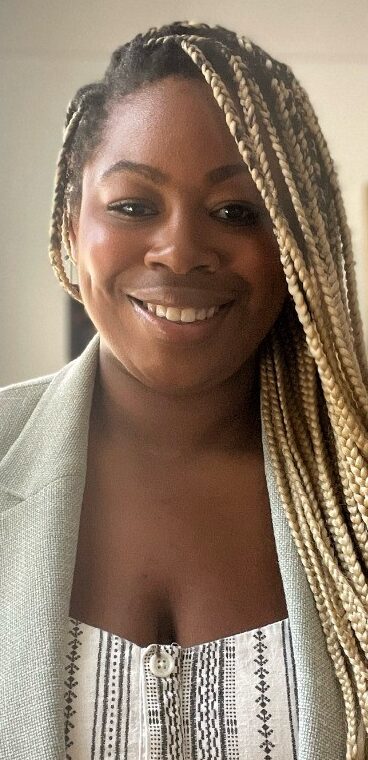 “When the stories are being reported they are not being reported from the perspective of someone in that community. You don’t get all of the nuances and the true devastation of that community,” Lucia Priselac (pictured), director of the Uproot Project, has said.
“When the stories are being reported they are not being reported from the perspective of someone in that community. You don’t get all of the nuances and the true devastation of that community,” Lucia Priselac (pictured), director of the Uproot Project, has said.
Nor do we hear enough about the self-empowering success stories, Priselac said over lunch at the University of Pennsylvania complex, site of the SEJ conference. She cited the Grow Dat Youth Farm in New Orleans, where community residents grow food on a former golf course in the Central City to address that community’s designation as a food desert.
The Uproot Project facilitates networking, provides a space to share stories, awards fellowships, publishes a biweekly online newsletter, and maintains a private Slack channel. Its long-term mission is holding newsrooms accountable for environmental coverage of people of color, said Priselac and her colleague, Sofia Prado Huggins, a Venezuela native and the group’s project and social media manager.
True, the Society for Environmental Journalists is overwhelmingly white, but that, too, is slowly changing.
 The family of its new executive director, Aparna Mukherjee (pictured), immigrated from India in the 1970s, though she was born in New York. Asian Americans were clearly in evidence at the convention. Some of those present as fellowship recipients were from abroad.
The family of its new executive director, Aparna Mukherjee (pictured), immigrated from India in the 1970s, though she was born in New York. Asian Americans were clearly in evidence at the convention. Some of those present as fellowship recipients were from abroad.
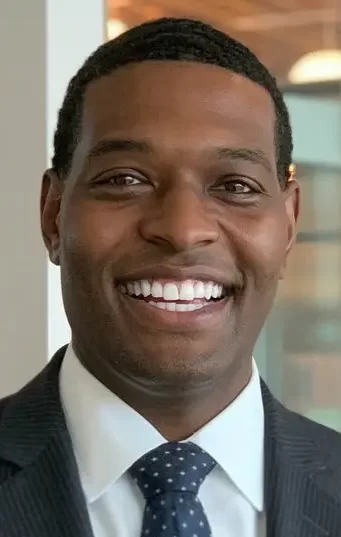 This year the group, founded in 1990, heard from Michael Regan (pictured), the first Black male administrator of the Environmental Protection Agency.
This year the group, founded in 1990, heard from Michael Regan (pictured), the first Black male administrator of the Environmental Protection Agency.
Regan defended a new $20 billion federal “green bank” program, saying it will finance a variety of projects to create low-carbon solutions to combat climate change, including in disadvantaged communities that are most affected by pollution, Matthew Daly reported Friday for the Associated Press.
That proposal was applauded by the NAACP, which declared, “The history of climate calamities in Black communities underscores the urgency of addressing environmental and racial injustices on a global scale. Prioritizing Black voices and capital is crucial in shaping the future to ensure a world that uplifts equity, justice, and sustainability for all.”
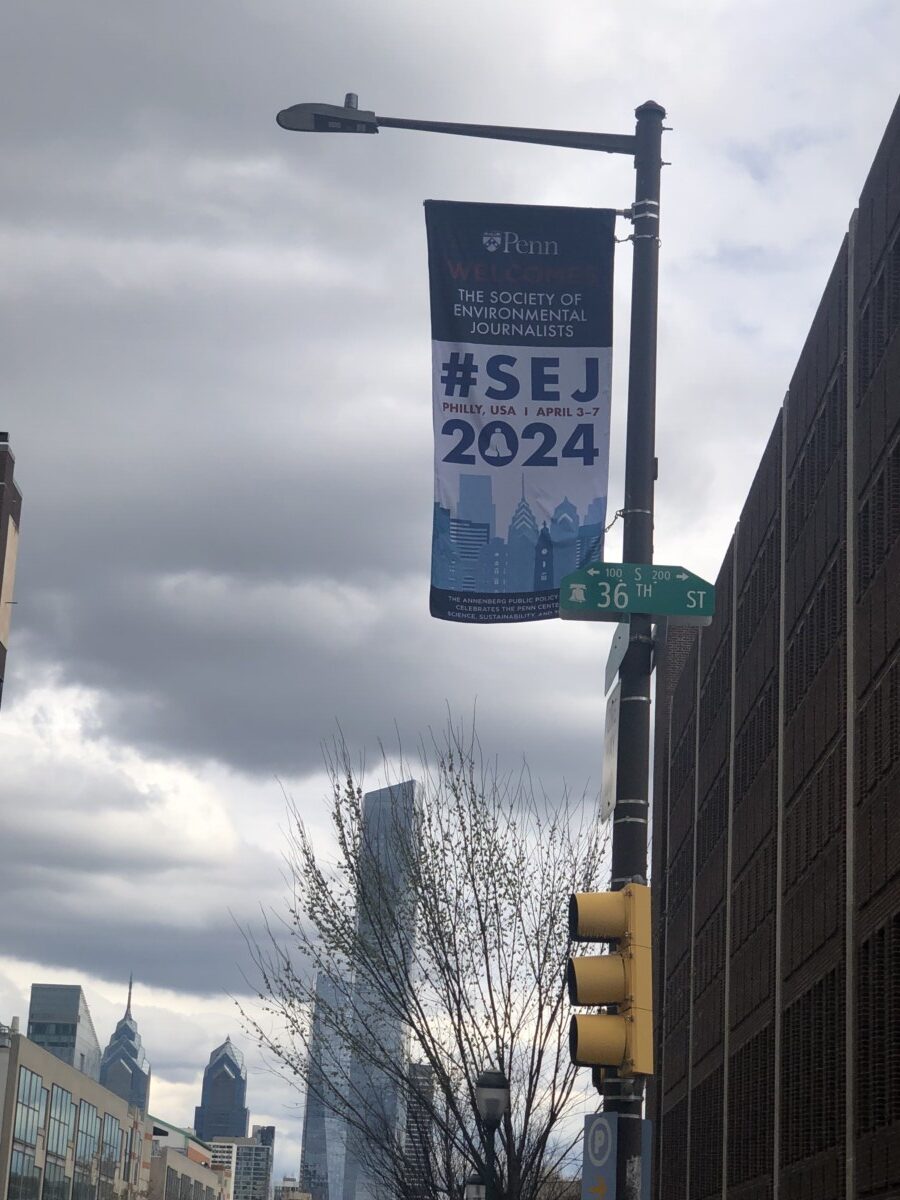 The previous week, Regan announced “the first ever HBCU-MSI Advisory Council, a major step forward in our commitment to diversity, equity, and inclusion at EPA.” The initials refer to historically Black colleges and universities and minority-serving institutions. “By harnessing the unique insights and energy of students and faculty from HBCUs and MSIs, we are ensuring the future of environmental leadership is diverse and dynamic.” (Photo: On University of Pennsylvania campus; credit Richard Prince)
The previous week, Regan announced “the first ever HBCU-MSI Advisory Council, a major step forward in our commitment to diversity, equity, and inclusion at EPA.” The initials refer to historically Black colleges and universities and minority-serving institutions. “By harnessing the unique insights and energy of students and faculty from HBCUs and MSIs, we are ensuring the future of environmental leadership is diverse and dynamic.” (Photo: On University of Pennsylvania campus; credit Richard Prince)
Convention panels addressed such topics as “Covering the Environmental Impact of War,” “Communicate, Don’t (Just) Infuriate: Strengthening How Climate Journalism Converses With the World, “Working With Whistleblowers” and “From the Margins to the Mainstream: Rethinking Environmental Justice Coverage.”
The latter panel, moderated by Evlondo Cooper of Media Matters for America, promised to “highlight the systemic reasons behind the lack of coverage, including a lack of diversity in newsrooms and prevailing editorial biases. Panelists will provide tips on the ways journalists can champion the role of nonwhite media outlets and integrate persons of color into mainstream reporting, ensuring diverse and inclusive coverage of environmental issues. A crucial part of this approach is the inclusion of community voices, especially those impacted by hazardous waste and pollution.”
A session on the 2024 election offered advice and cautions. “Turnout is going to be everything for the climate movement,” said Nathaniel Stinnett, founder and executive director of the Environmental Voter Project. But those who care most deeply about environmental issues are much more likely to be nonvoters. Speaking of the Infrastructure Investment and Jobs Act, Stinnett added, “Biden secured the largest climate law in U.S. history and nobody knows about it. . . . If the climate voters don’t show up big time, he’s toast.”
Others urged climate supporters to stress local initiatives with voters. but, said moderator Ximena Bustillo of NPR, “Talking about climate change is not helping us. It’s seen as one more progressive issue.”
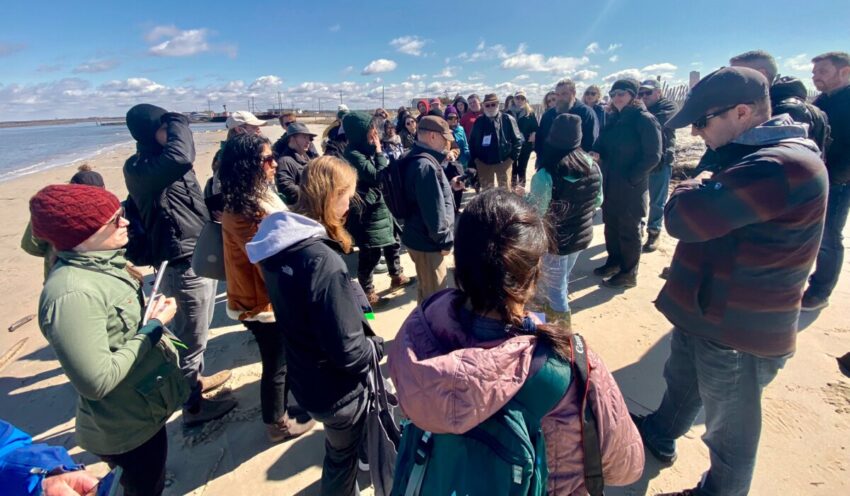
A tour of the hidden rural lands and stories of New Jersey took SEJ members to southern New Jersey farms and the Pinelands National Reserve, where guest speakers encouraged attendees to engage critically with the history of rural lands, highlight Indigenous perspectives and learn about farming practices, Astrid Code and Ava Chatlosh reported for the inaugural SEJ student newsroom team. (Credit: Gwendolyn Craig/X)
A closing plenary on Saturday took on artificial intelligence, how to channel anger into productive journalism, and whether accepting advertising from fossil-fuel companies compromises the integrity of the journalism. The answers were delivered with the surety that the respondents are on the right side of history. Few media outlets see the need any longer to include climate deniers in the name of “balanced” coverage.
Everyone is affected by climate, they said. “It’s almost trite to say it’s an ‘everything’ beat, replied Tony Barboza, editorial Writer for the Los Angeles Times and SEJ board member; every beat has a climate component.
But how inclusive will that reporting be? The words of the Uproot Project’s Priselac and Huggins also ring true: “Who else is going to advocate for us if not us?”
- Student newsroom, Society of Environmental Journalists: #SEJ2024 Live Coverage
- Qosim Suleiman, Premium Times, Nigeria: PREMIUM TIMES’ Journalist, others selected for SEJ Diversity Fellowship (Jan. 31)
Cuban rapper Maykel Osorbo, now imprisoned, performs “Un Dia,” (“One Day”). The lyrics include, “I protest, for the dead and those under arrest, for my people who have an uncertain future, those who abuse their position. I dream of freedom, prosperity, progress, that for telling the truth, no one goes to jail anymore.” (Credit: YouTube)
Amnesty Int’l Calls Out Cuba on Denial of Freedoms
Amnesty International is calling for Cuba to “to immediately and unconditionally release all individuals detained for exercising their right to freedom of expression and peaceful assembly,” and urged Cuban authorities “to cease subjecting human rights activists and journalists to surveillance and arbitrary detention, including de facto house arrest.”
Reporters Without Borders has said that “Cuba remains, year in and year out, the worst country for press freedom in Latin America,” ranking it 172 of 180 countries on its World Press Freedom Index.
Amnesty’s March 25 statement to the United Nations Human Rights Council coincided with the death of Cuban dissident and former political prisoner Daniel Santovenia Fernández, who died at 69 in the province of Matanzas, a victim of cardiorespiratory arrest.
He was released in 2018 after serving a 30-year sentence as one of three Miami-based Cubans who in 1991 were captured with arms and explosives when they arrived clandestinely in Cuba to start a campaign of sabotage. “I came to Cuba to fight for the freedom of my country, to give a free homeland to my children so that here they could live happily, with the protection of human rights,” he said on his release.
“During his long stay in prison, Santovenia faced inhumane conditions, including torture and medical neglect, according to his own accounts and testimonies from those who shared his captivity,” the website CiberCuba reported.
“In an interview with CubaNet in 2020, the former prisoner said that among the forms of torture was poor nutrition, which included bread and sugar water for breakfast; the rice sometimes had worms in it, and the peas or flour arrived with weevils: ‘They had to eat it because there was nothing else,’ he said.”
Rep. Debbie Wasserman Schultz, D-Fla., wrote to Secretary of State Antony Blinken supporting the release of Cuban artists and activists Luis Manuel Otero Alcántara and Maykel “Osorbo” Castillo Pérez and all political prisoners, activist Anamely Ramos noted in a March 29 Facebook posting.
The two artists took part in composing and recording “Patria y Vida” (video), the viral rap song that “became the anthem for disaffected Cubans banned by Cuba’s Communist regime and won two Latin Grammys,” as the Center for a Free Cuba reported.
Castillo was being held incommunicado and in a punishment cell “because they do not want to give him the phone and he has protested,” Ramos said on Facebook.

In 2019, Amnesty International named five Cuban prisoners of conscience – “people imprisoned solely because of the peaceful exercise of their human rights“ – and called for their immediate and unconditional release. “We know so far that two people were released, but at least one of them (if not both) has been detained again,” an Amnesty spokesperson says.
“Cuba’s response to the protests on July 11 and 12, 2021 – including mass incarcerations, the use of arbitrary detentions, and the implementation of a new Penal Code that intensifies censorship – indicate a worrying disregard for fundamental freedoms,” Amnesty said.
“Although Cuba accepted during the 2022 review the recommendation to ‘ensure that prisoners are treated with dignity and humanity’ in line with the Minimum Standards for the Treatment of Prisoners, Amnesty International has received multiple reports since then of ongoing mistreatment in prisons, violations of the right to due process, and the use of incommunicado detention.”
The organization also said, “Cuba must also repeal articles of the new Penal Code that criminalize dissent and limit freedom of expression in line with recommendations it has received.
“Finally, we insist that Cuba implement recommendations to abolish the death penalty and promptly ratify, without making any reservation, the International Covenant on Civil and Political Rights, the International Covenant on Economic, Social and Cultural Rights. Cuba should also accede to the Optional Protocol to the Convention against Torture and Other Cruel, Inhuman or Degrading Treatment or Punishment and the Rome Statute of the International Criminal Court, and allow access for human rights organizations, as well as extend invitations to the United Nations human rights special procedures to visit the country.”
Amnesty followed up Friday with an announcement that it had published the book “Images of Rebellion,” “an extraordinary visual compilation that chronicles and celebrates the defiant spirit of civil resistance in Cuba. The book contains a poignant selection of the more than 21,000 letters and drawings sent to Luis Manuel Otero Alcántara, Cuban artist and prisoner of conscience, in a global outpouring of support. . . .
“The book is available for free in English and Spanish in digital format at cubasinrepresion.org to reach as many people as possible with Images of [Rebellion’s] message of resistance and hope.”
 Separately, “Cuban ruler Miguel Díaz-Canel declared during a visit to the official newspaper Granma his interest in that newspaper becoming the most read digitally in the country,” CiberCuba reported Saturday.
Separately, “Cuban ruler Miguel Díaz-Canel declared during a visit to the official newspaper Granma his interest in that newspaper becoming the most read digitally in the country,” CiberCuba reported Saturday.
However, the publication added, “Criticism of the Cuban official press, especially the reports of the Granma newspaper, is recurrent among the island’s population, tired of triumphalist readings, without reflecting the daily life of Cubans and taking advantage of all events to glorify a government administration that has the country in one of the worst economic and social crises in its history.”
- Amnesty International: Cuba: Release Yoruba Prisoners of Conscience (June 21, 2023)
- Amnesty International: Cuba: Prisoner of Conscience Maykel Osorbo in Danger (Aug. 1, 2023)
- Teo A. Babun, Miami Herald: I believe Cuba is at the tipping point: Are we in the U.S. ready to respond? (paywall)
- Rafael Bernal, The Hill: Maryland faith, civil rights leaders to Cardin: Lift the Cuban embargo
- Rocio Baró.Guerra, Miami Herald: Healthcare in Cuba is free, but at what cost? (paywall)
- Editorial, Miami Herald: Is Cuba becoming kinder, gentler toward demonstrators, or weaker and more hypocritical? (paywall)
- Mary Anastasia O’Grady, Wall Street Journal: How Americans Betray the Cuban People: Brave protesters take to the streets again. They lack solidarity from abroad. (May 14, 2023) (paywall)
- UN Watch: Cuban Ambassador attacks UN Watch for inviting Rosa Maria Paya to speak at the United Nations
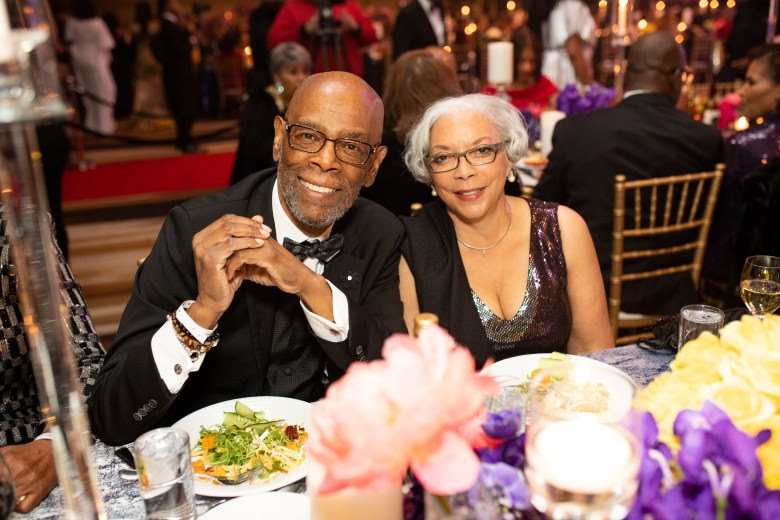
James Washington and his wife, Janis L. Ware, publisher of the Atlanta Voice, at the United Negro College Fund Mayor’s Masked Ball in Atlanta in 2022. (Credit: Itoro N. Umontuen/Atlanta Voice)
James Washington Dies, Trailblazer for Black Press
“No matter the time, day or night, if you needed to talk with James Washington, he was ready to listen, whether you were talking about your spouse, your children or even a story idea for the next edition of The Atlanta Voice,” Rebecca McCarthy reported Sunday for the Atlanta Journal-Constitution.
“ ‘He was very genuine in caring about the people he worked with, beyond the employee-boss relationship,’ said Craig Allen Brown, who worked with Washington in 2018. ‘He was great to me as a young journalist. Our conversations would start small and then go from there, with him asking me if I was being the best husband, the best friend.’
“James Alfred Washington, 73, president and general manager of The Atlanta Voice and a long-time advocate of Black media excellence had battled cancer in recent years. He died at home April 3. Black newspapers around the country carried the news of his passing, and many called him a trailblazer for the Black press.
“ ‘He led with love,’ said Itoro Umontuen, managing editor of The Atlanta Voice. ‘And he was constantly looking for ways to innovate, ways to incorporate new technologies into making the paper better.’ . . . ”
Donnell Suggs added for the Atlanta Voice, “For over four decades, Washington had been involved in nearly every level of the communications field. From his time as the publisher of The Dallas Weekly, a Black-owned and operated publication, to his work as the public relations manager for the Dallas Ballet, Washington had always been a strong representation of Black excellence and intelligence. . . .”
The National Association of Black Journalists awarded Washington its Legacy Award in 2019. The organization said then, “As a prominent publisher among the Black Press, Washington has made constant efforts to promote the value of diversity and inclusion in the newsroom and the value of African American news leadership and ownership.”
“Jim’s commitment to media entrepreneurship and ensuring that the black perspective is present in news coverage is what makes his legacy so special,” then-NABJ President Sarah Glover said in that announcement. “His dedication to the industry has opened many doors not just for himself, but for the many journalists that have and will come behind him.”
- Stacy M. Brown, National Newspaper Publishers Association: Farewell to James A. Washington: A Trailblazer in Black Journalism and Community Advocacy
- Tracie Powell, Pivot Fund: James Washington: Champion of Black Journalism and Mentor
Marvin Lake, Virginian-Pilot Pioneer, Had Dementia
Marvin L. Lake (pictured), who died March 27 as the first African American reporter, editor and public editor of The Virginian-Pilot in Norfolk, Va., had been in the later stages of dementia, his wife, Ruby Fararr-Lake, told Journal-isms.
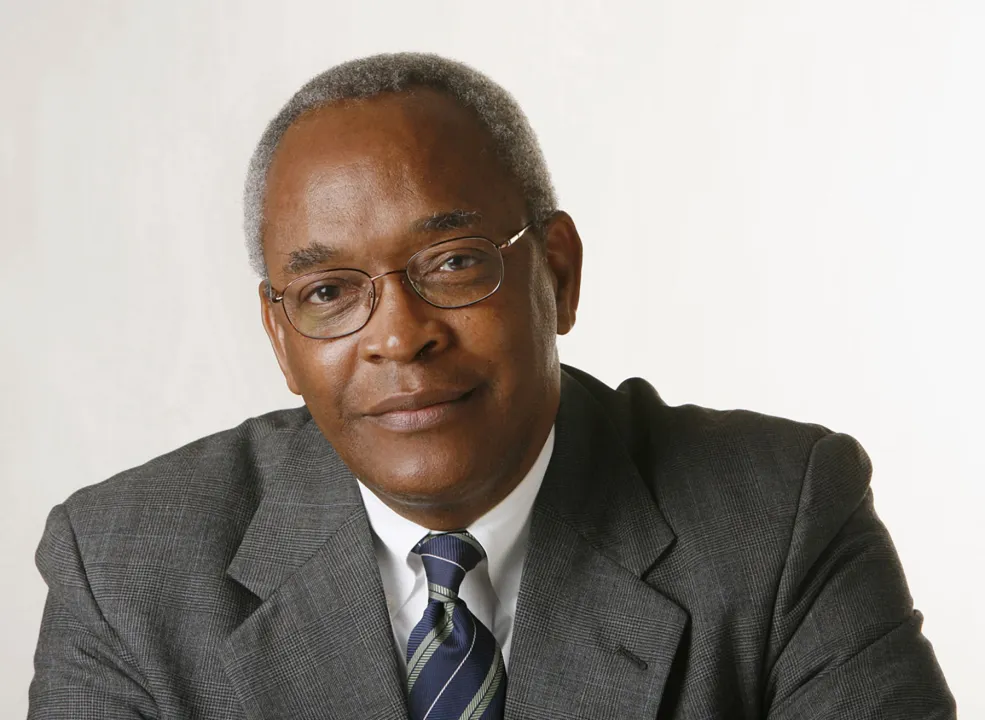 Despite his many public-facing roles, his wife said, Lake was a “very, very private person” and did not let many know of his dementia. But the disease needs more public discussion, she said, “to make more people aware, and especially to pinpoint the type” and to understand how to treat it better. “It would make it easier for families who have to care for their loved ones, Farrar-Lake said, and aid in providing such benefits as getting test results faster.
Despite his many public-facing roles, his wife said, Lake was a “very, very private person” and did not let many know of his dementia. But the disease needs more public discussion, she said, “to make more people aware, and especially to pinpoint the type” and to understand how to treat it better. “It would make it easier for families who have to care for their loved ones, Farrar-Lake said, and aid in providing such benefits as getting test results faster.
According to the Centers for Disease Control and Prevention, “An estimated 6.5 million persons aged ≥65 years in the United States live with Alzheimer disease, the most common dementia . . . . This number is projected to double by 2060, with the largest increase among non-Hispanic Black or African American (Black), and Hispanic or Latino (Hispanic) adults . . .
“Dementia is not a specific disease but is rather a general term for the impaired ability to remember, think, or make decisions that interferes with doing everyday activities. Alzheimer’s disease is the most common type of dementia. Though dementia mostly affects older adults, it is not a part of normal aging.
“Of those at least 65 years of age, there [are] an estimated 5.0 million adults with dementia in 2014 and projected to be nearly 14 million by 2060.”
“Neurodegenerative dementias, like Alzheimer’s disease, have no cure, though there are medications that can help protect the brain or manage symptoms such as anxiety or behavior changes. Research to develop more treatment options is ongoing. . . .”
In lieu of flowers, the family asked that donations be made in Lake’s honor to Norfolk State University, Shiloh Baptist Church Legacy Fund, or the Alzheimer’s Association. (Photo credit: Bill Tiernan/Virginian Pilot)
- Roger Chesley, Virginia Mercury: Journalist was trailblazer, mentor, paper’s racial conscience
- Eliza Noe, Virginian-Pilot: Marvin Lake, The Virginian-Pilot’s first Black reporter, dies at 80
Short Takes
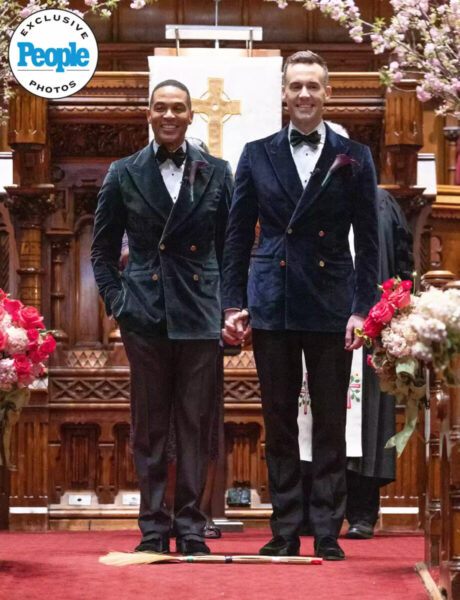
The wedding at Fifth Avenue Presbyterian Church in Manhattan was officiated by Linda Thomas-Greenfield, U.S. ambassador to the United Nations. (Credit: Tony Valdez)
- People magazine scored exclusive photos of the New York wedding Saturday of former CNN anchor Don Lemon and his beau, Tim Malone. “The happy event was watched by a star-studded guest list, which included legendary music executive and producer Clive Davis, Joy Behar, Sara Haines, Ana Navarro-Cárdenas and Sunny Hostin from The View,” Jason Sheeler reported. “Additional guests included former Today show anchor Matt Lauer and girlfriend Shamin Abas, Real Housewives of New York City alum Luann de Lesseps, Sex and the City and Emily in Paris creator Darren Star, Tamron Hall and Alec and Hilaria Baldwin. CNN’s Kate Bolduan, Erin Burnett and Dana Bash also attended. . . . ” The Root adds, “Internet Reacts to Don Lemon’s Celebrity-Packed Wedding Nuptials.”
- “As you watch today’s eclipse on TV or through glasses, keep front of mind that Benjamin Banneker, a revered Black astronomer and mathematician, predicted the total solar eclipse of 1789, advancing science and how Black people were viewed in society,” Melanie Eversley, editor of NABJ News and Views, reminded readers Monday. “As author Rachel Jamison Webster, a Banneker descendant, writes in an essay exclusively for Black News & Views, the Dogon people of Africa excelled in astronomy, as did Banneker’s father, who passed his expertise onto his bright and curious son. . . .”
- “A radio preservation project focused on audio archives of Historically Black Colleges and Universities is expanding to 29 stations with a $5 million grant from the Mellon Foundation,” Weslan Hansen reported Thursday for Current. “The HBCU Radio Preservation Project is a collaboration between the WYSO Archives in Yellow Springs, Ohio, and the Northeast Document Conservation Center of Andover, Mass. The partners will support HBCUs in digitizing their radio archives, contextualizing historical material through the production of oral histories and research, and building infrastructure to share their collections as digital media. . . .”

- The D.C. Journalism Job Fair, a joint effort of the Washington, D.C., chapters of the National Association of Hispanic Journalists, National Association of Black Journalists, Association of LGBTQ+ Journalists (NLGJA), Asian American Journalists Association, Society of Professional Journalists and the Journalism and Women Symposium, took place Saturday with 206 registrants, Brandon Benavides, NAHJ chapter president, said. Longest lines were for the tables for The New York Times and NPR. Georgetown University’s masters of journalism program hosted. (Credit: Richard Prince)
- “In October 2022, the first of several thousand lawsuits was filed at the Dirksen Federal Courthouse in the Loop by a woman from St. Louis claiming that chemicals in hair relaxer products she used — such as Soft Sheen, Just for Me and Dark & Lovely — caused her cancer,” Andy Grimm and Natalie Moore reported Thursday for the Chicago Sun-Times and WBEZ. “Near-identical lawsuits began piling up in state and federal courts across the U.S. The federal cases — now counting 8,500 plaintiffs, with more added every week — were consolidated last year in front of a single federal judge in Chicago. Dozens of cases have been filed in Cook County, and dozens more are in front of judges in local jurisdictions across the country.” Jasmine Valentine, owner of a hair styling business, said, “Black women historically relaxed their hair because ‘we were taught to hate ourselves. We were taught to hate our skin. We were taught to hate anything that was ethnic and natural about us. So they put people on TV that were lighter, that had straighter hair. Or that looked a certain way and, you know, everybody wants to live up to those standards.’ ”
- Gov. Tony Evers on Thursday signed into law a bipartisan bill requiring Wisconsin schools to teach Asian American and Hmong American histories, the Associated Press reported Thursday. “Evers signed the bill at an elementary school in Wausau, which is home to about 4,700 Hmong. That is 12% of the city’s residents, making Wausau the highest per-capita Hmong population in the state and country, according to the Hmong American Center. . . . Current Wisconsin law requires K-12 schools to teach Black, Hispanic and Native American histories. The new law adds Hmong and Asian American histories to this required curriculum. The goal is to promote greater awareness and understanding of Hmong and Asian American histories, cultures and traditions. . . .”
 “Miguel Gonzalez (pictured), a gifted and experienced editor who spent 25 years at The Wall Street Journal, most recently overseeing its Politics and Policy newsletter, is joining The Times as day editor for the Politics desk,” the New York Times announced April 1.
“Miguel Gonzalez (pictured), a gifted and experienced editor who spent 25 years at The Wall Street Journal, most recently overseeing its Politics and Policy newsletter, is joining The Times as day editor for the Politics desk,” the New York Times announced April 1.
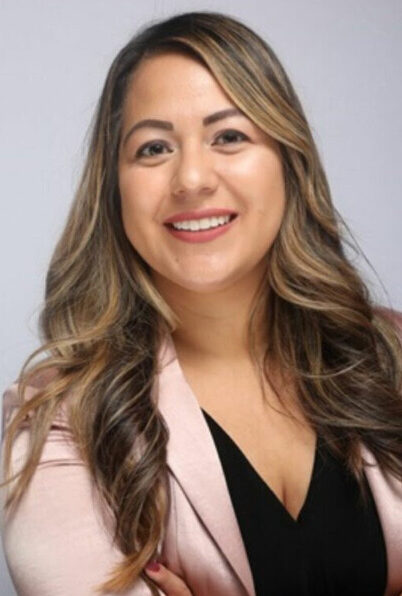 Diana Maltez (pictured), whose “career includes leadership roles at nationally recognized non-profit and Hispanic organizations such as Prospanica, the Hispanic Association on Corporate Responsibility and LATINA Style Magazine,” has joined the National Association of Hispanic Journalists as director of development, NAHJ announced. “She has worked closely with Fortune 500 companies on diversity and inclusion initiatives, focusing on hiring, retaining, and promoting Hispanic talent. . . .”
Diana Maltez (pictured), whose “career includes leadership roles at nationally recognized non-profit and Hispanic organizations such as Prospanica, the Hispanic Association on Corporate Responsibility and LATINA Style Magazine,” has joined the National Association of Hispanic Journalists as director of development, NAHJ announced. “She has worked closely with Fortune 500 companies on diversity and inclusion initiatives, focusing on hiring, retaining, and promoting Hispanic talent. . . .”
- Willie James Pye was put to death by lethal injection in the state’s first execution in over four years last week,” Chaya Tong reported March 28 for the Georgia Recorder. “Pye was pronounced dead at 11:03 p.m. March 20 at the state prison in Jackson after being convicted for a 1993 kidnapping, rape and murder of his former girlfriend. But despite the case’s significance and national attention over Pye, the public’s view of the execution itself was restricted under state protocol blocking media witnesses for state executions from critical parts of the process. Two days before Pye’s execution, the American Civil Liberties Union filed an emergency appeal to the Georgia Supreme Court challenging media witness restrictions ahead of Pye’s March 20 execution. . . . The Georgia Supreme Court denied the ACLU’s emergency appeal in advance of Pye’s execution, but the lawsuit, which names Georgia Department of Corrections Commissioner Tyrone Oliver, Georgia Diagnostic and Classification Prison Warden Shawn Emmons, and Georgia Attorney General Chris Carr as defendants, is not over. . . .”
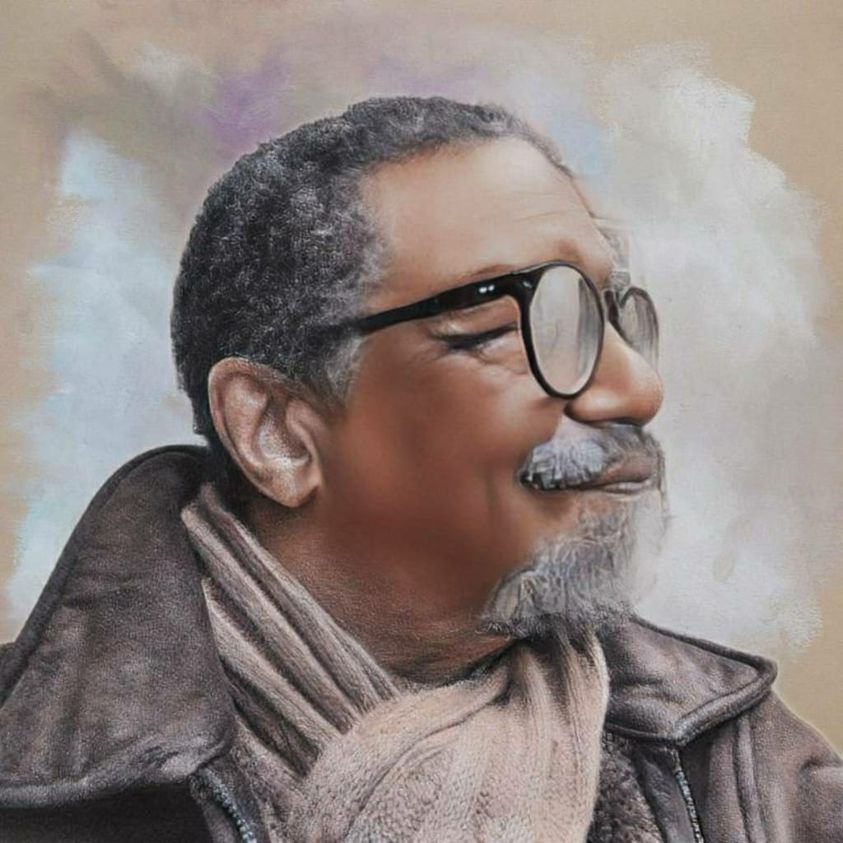 Services for Tony Regusters (depicted) the “Afrofuturist intellectual” best known for co-creating the early BET show “Teen Summit” and producing a film of then-president Barack Obama’s highly symbolic 2009 visit to Ghana, are scheduled for Friday, April 12, in Philadelphia. They take place at Camphor Memorial United Methodist Church, 620 Wyalusing Ave. Viewing is 10 a.m. to 11 a.m., with the service at 11. A repast in the church hall follows. Regusters died March 27.
Services for Tony Regusters (depicted) the “Afrofuturist intellectual” best known for co-creating the early BET show “Teen Summit” and producing a film of then-president Barack Obama’s highly symbolic 2009 visit to Ghana, are scheduled for Friday, April 12, in Philadelphia. They take place at Camphor Memorial United Methodist Church, 620 Wyalusing Ave. Viewing is 10 a.m. to 11 a.m., with the service at 11. A repast in the church hall follows. Regusters died March 27.
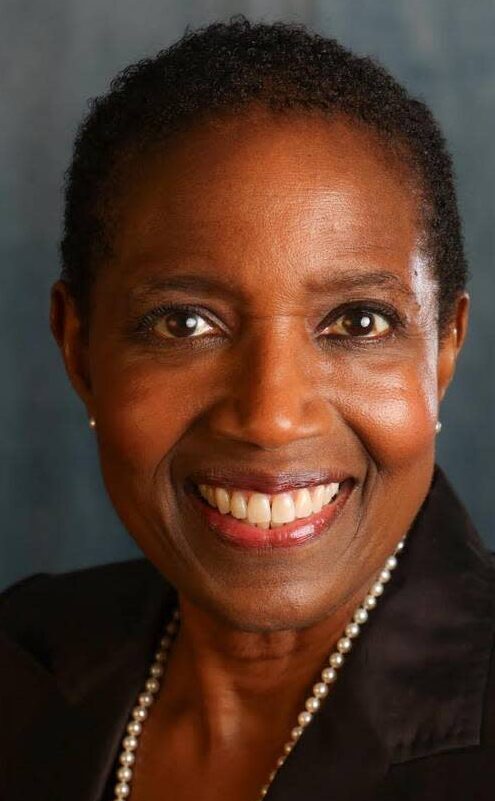 A celebration of life is planned for Nancy Ancrum (pictured), longtime Miami Herald editorial page editor, on Saturday, April 13, at Fairchild Tropical Botanic Garden in Coral Gables, Fla., the Herald reports. The memorial is open to the public. The services will be 11 a.m. to 12:30 p.m. at the garden house of Fairchild at 10901 Old Cutler Road. Ancrum died Feb. 9, just weeks after retiring.
A celebration of life is planned for Nancy Ancrum (pictured), longtime Miami Herald editorial page editor, on Saturday, April 13, at Fairchild Tropical Botanic Garden in Coral Gables, Fla., the Herald reports. The memorial is open to the public. The services will be 11 a.m. to 12:30 p.m. at the garden house of Fairchild at 10901 Old Cutler Road. Ancrum died Feb. 9, just weeks after retiring.
- Sudan on Tuesday suspended the work of Saudi state-owned broadcasters Al Arabiya, Al Hadath and UAE-owned Sky News Arabia channel “due to its lack of commitment to the required professionalism and transparency and failure to renew its licenses,” Sudanese state news agency (SUNA) said, Yomna Ehab and Adam Makary reported for Reuters. “The Sudanese Journalists Syndicate condemned the decision by the information ministry, saying it was a clear violation of freedom of expression and freedom of the press. . . .”
To subscribe at no cost, please send an email to journal-isms+subscribe@groups.io and say who you are.
Facebook users: “Like” “Richard Prince’s Journal-isms” on Facebook.
Follow Richard Prince on Twitter @princeeditor
Richard Prince’s Journal-isms originates from Washington. It began in print before most of us knew what the internet was, and it would like to be referred to as a “column.” Any views expressed in the column are those of the person or organization quoted and not those of any other entity. Send tips, comments and concerns to Richard Prince at journal-isms+owner@
View previous columns (after Feb. 13, 2016).
View previous columns (before Feb. 13, 2016)
- Diversity’s Greatest Hits, 2018 (Jan. 4, 2019)
- Book Notes: Is Taking a Knee Really All That? (Dec. 20, 2018)
- Book Notes: Challenging ’45’ and Proudly Telling the Story (Dec. 18, 2018)
- Book Notes: Get Down With the Legends! (Dec. 11, 2018)
- Journalist Richard Prince w/Joe Madison (Sirius XM, April 18, 2018) (podcast)
- Richard Prince (journalist) (Wikipedia entry)
- February 2018 Podcast: Richard “Dick” Prince on the need for newsroom diversity (Gabriel Greschler, Student Press Law Center, Feb. 26, 2018)
- Diversity’s Greatest Hits, 2017 — Where Will They Take Us in the Year Ahead?
- Book Notes: Best Sellers, Uncovered Treasures, Overlooked History (Dec. 19, 2017)
- An advocate for diversity in the media is still pressing for representation, (Courtland Milloy, Washington Post, Nov. 28, 2017)
- Morgan Global Journalism Review: Journal-isms Journeys On (Aug. 31, 2017)
- Diversity’s Greatest Hits, 2016
- Book Notes: 16 Writers Dish About ‘Chelle,’ the First Lady
- Book Notes: From Coretta to Barack, and in Search of the Godfather
- Journal-isms’ Richard Prince Wants Your Ideas (FishbowlDC, Feb. 26, 2016)
- “JOURNAL-ISMS” IS LATEST TO BEAR BRUNT OF INDUSTRY’S ECONOMIC WOES (Feb. 19, 2016)
- Richard Prince with Charlayne Hunter-Gault, “PBS NewsHour,” “What stagnant diversity means for America’s newsrooms” (Dec. 15, 2015)
- Book Notes: Journalists Follow Their Passions
- Book Notes: Journalists Who Rocked Their World
- Book Notes: Hands Up! Read This!
- Book Notes: New Cosby Bio Looks Like a Best-Seller
- Journo-diversity advocate turns attention to Ezra Klein project (Erik Wemple, Washington Post, March 5, 2014)
